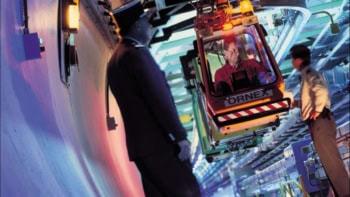By Matin Durrani
With storm-force winds and heavy rain battering the Physics World headquarters here in Bristol, UK, I can’t say I’ve really got that summer feeling at all.
But summer it is and today marks the start of UEFA Euro 2012 in Poland and Ukraine, in which 16 of Europe’s top men’s international football teams fight it out to be crowned champions of Europe.
Spain, who won the tournament last time it was held in 2008, remain favourites in my book, but you can never write off the Germans in big competitions, while France and the Netherlands are in with a definite shout. As for England and Italy, I think both will struggle.
All of which is a decent excuse for me to remind you of one of Physics World‘s most popular feature articles ever, entitled simply “The physics of football”, which you can read here.
Co-authored by Steve Haake from Sheffield Hallam University in the UK, the article looks at why footballs can be made to swerve spectacularly through the air, using a famous 1997 free kick by legendary Brazilian defender Roberto Carlos as an example.
Struck 30 m from the opponents’ goal, the ball was heading so far wide of the net that a ball-boy, standing several metres to the right of the goal, instinctively ducked his head in response. Once the ball had cleared the wall of defenders, it took a wicked late swerve before arriving, astonishingly, in the top right-hand side of the net.
If Haake’s analysis of how this happened leaves you wanting more, then check out a paper published in 2010 by our colleagues on New Journal of Physics, which looked in greater detail at Carlos’s wonder goal.
And don’t forget this analysis by two US sports scientists of bending balls, which led to some interesting conclusions about another famous free kick, this time taken by David Beckham in 2001.



